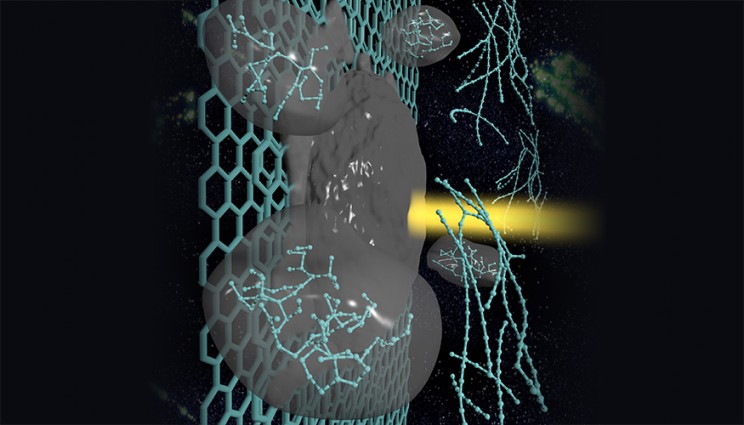A material that’s tougher than diamond is the object of interest for researchers at the US Department of Energy’s Lawrence Livermore National Laboratory (LLNL) according to a Sept. 18, 2015 news item by Beth Ellison on Azonano (Note: A link has been removed),
Researchers at Lawrence Livermore National Laboratory (LLNL) have explored a method that uses laser-melted graphite to develop linear chains of carbon atoms.
This material, referred to as carbyne, could possess numerous unique properties, such as modification of the quantity of electrical current passing through a circuit according to the needs of a user. This research could probably lead to the creation of tiny electronics capable of turning on and off at an atomic scale.
A Sept. 17, 2015 LLNL news release (also on EurekAlert) details the research (Note: A link has been removed),
Carbyne is the subject of intense research because of its presence in astrophysical bodies, as well as its potential use in nanoelectronic devices and superhard materials. Its linear shape gives it unique electrical properties that are sensitive to stretching and bending, and it is 40 times stiffer than diamond. It also was found in the Murchison and Allende meteorites and could be an ingredient of interstellar dust.
Using computer simulations, LLNL scientist Nir Goldman and colleague Christopher Cannella, an undergraduate summer researcher from Caltech, initially intended to study the properties of liquid carbon as it evaporates, after being formed by shining a laser beam on the surface of graphite. The laser can heat the graphite surface to a few thousands of degrees, which then forms a fairly volatile droplet. To their surprise, as the liquid droplet evaporated and cooled in their simulations, it formed bundles of linear chains of carbon atoms.
“There’s been a lot of speculation about how to make carbyne and how stable it is,” Goldman said. “We showed that laser melting of graphite is one viable avenue for its synthesis. If you regulate carbyne synthesis in a controlled way, it could have applications as a new material for a number of different research areas, including as a tunable semiconductor or even for hydrogen storage.
“Our method shows that carbyne can be formed easily in the laboratory or otherwise. The process also could occur in astrophysical bodies or in the interstellar medium, where carbon-containing material can be exposed to relatively high temperatures and carbon can liquefy.”
Goldman’s study and computational models allow for direct comparison with experiments and can help determine parameters for synthesis of carbon-based materials with potentially exotic properties.
“Our simulations indicate a possible mechanism for carbyne fiber synthesis that confirms previous experimental observation of its formation,” Goldman said. “These results help determine one set of thermodynamic conditions for its synthesis and could account for its detection in meteorites resulting from high-pressure conditions due to impact.”
Here’s a link to and a citation for the paper,
Carbyne Fiber Synthesis within Evaporating Metallic Liquid Carbon by Christopher B. Cannella and Nir Goldman. J. Phys. Chem. C, 2015, 119 (37), pp 21605–21611 DOI: 10.1021/acs.jpcc.5b03781 Publication Date (Web): July 9, 2015 (print): Sept. 17, 2015
Copyright © 2015 American Chemical Society
This paper is behind a paywall.
Dexter Johnson in a Sept. 18, 2015 posting about the latest carbyne developments on his Nanoclast blog (on the IEEE [Institute for Electrical and Electronics Engineers] website) provides a little history (Note: Links have been removed),
A couple of years ago, a material dubbed carbyne—which is a chain of carbon atoms held together by either double or alternating single and triple atomic bonds—was awarded the title of the world’s strongest material. Later, scientists also demonstrated that it has the unusual property of being able to change from being a conductor to an insulator when it’s stretched by as little as 3 percent.
Here’s an image illustrating the process,
